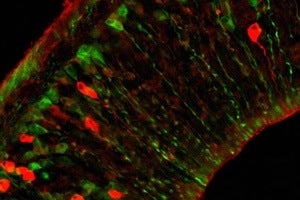
Microchimerism results when cells from two genetically distinct populations appear in the same tissue, organ, or individual, such as occurs during an organ transplant or during pregnancy. It has been known for some time that, during pregnancy, fetal cells end up circulating within the mother’s bloodstream. A relatively new discovery, however, is that these fetal cells don’t just remain in the blood stream but travel to organs such as the heart or brain.
Until recently fetal microchimeric cells which traveled to the maternal brain had only been seen in mice. But a new study shows that microchimeric cells occur in humans as well.
To detect the microchimeric cells in the maternal brain, scientists at the Fred Hutchinson Cancer Research Center in Seattle performed PCR analysis on tissue from 59 autopsied female brains. They found in 63 percent of the brains genes that are unique to the Y-chromosome, indicating they originated from a male, thus, microchimeric cells from a male fetus the women had given birth to at some point in their lives. Microchimeric cells persist in the maternal blood stream for years after pregnancy.
What’s fascinating about these fetal cells is that they resemble pluripotent stem cells – they have the ability to become heart or brain cells. What this means functionally is still uncertain. But the potential for these so-called fetal microchimeric cells to incorporate and actually help repair maternal tissue is a new and exciting area of medical research.

But, like the child from which they originate, microchimeric cells have the potential to make the mother’s life both easier, and more difficult. Studies have linked the prolonged presence of the fetal cells in the mother’s blood to autoimmune disease. It is thought that the immature immune cells from the fetus stimulate inflammation and bring about autoimmune disease, such as in graft-versus-host disease in which immune cells from donated tissue attacks the host’s immune system. One study showed that fetal microchimeric cells were higher in women with multiple sclerosis, an autoimmune disease, compared to their siblings without multiple sclerosis. Some think that the increase in autoimmune disease among women over the past 40 years is due to the relationship between microchimeric cells, autoimmune disease, and abortion. Because the placenta is destroyed, an abortion results in a higher transfer of mircochimeric cells to the maternal bloodstream.
Further research is needed to elucidate the role of these interesting cells in the mother’s physiology. And perhaps, when more is known, they can be manipulated to either foster tissue repair or decrease the chance for autoimmune disease. From a scientific perspective, the bond between mother and child just got stronger, and even more complex.



